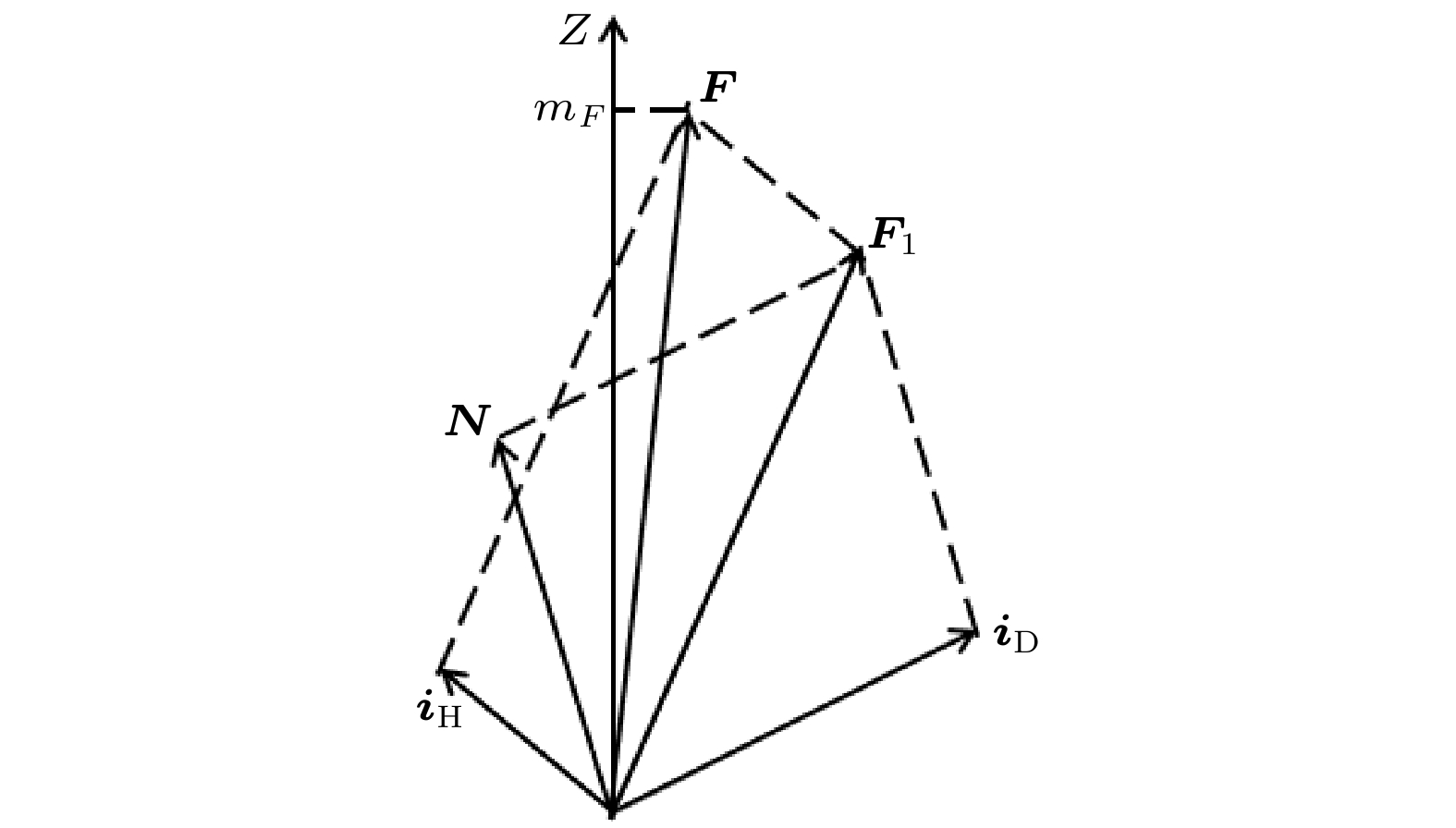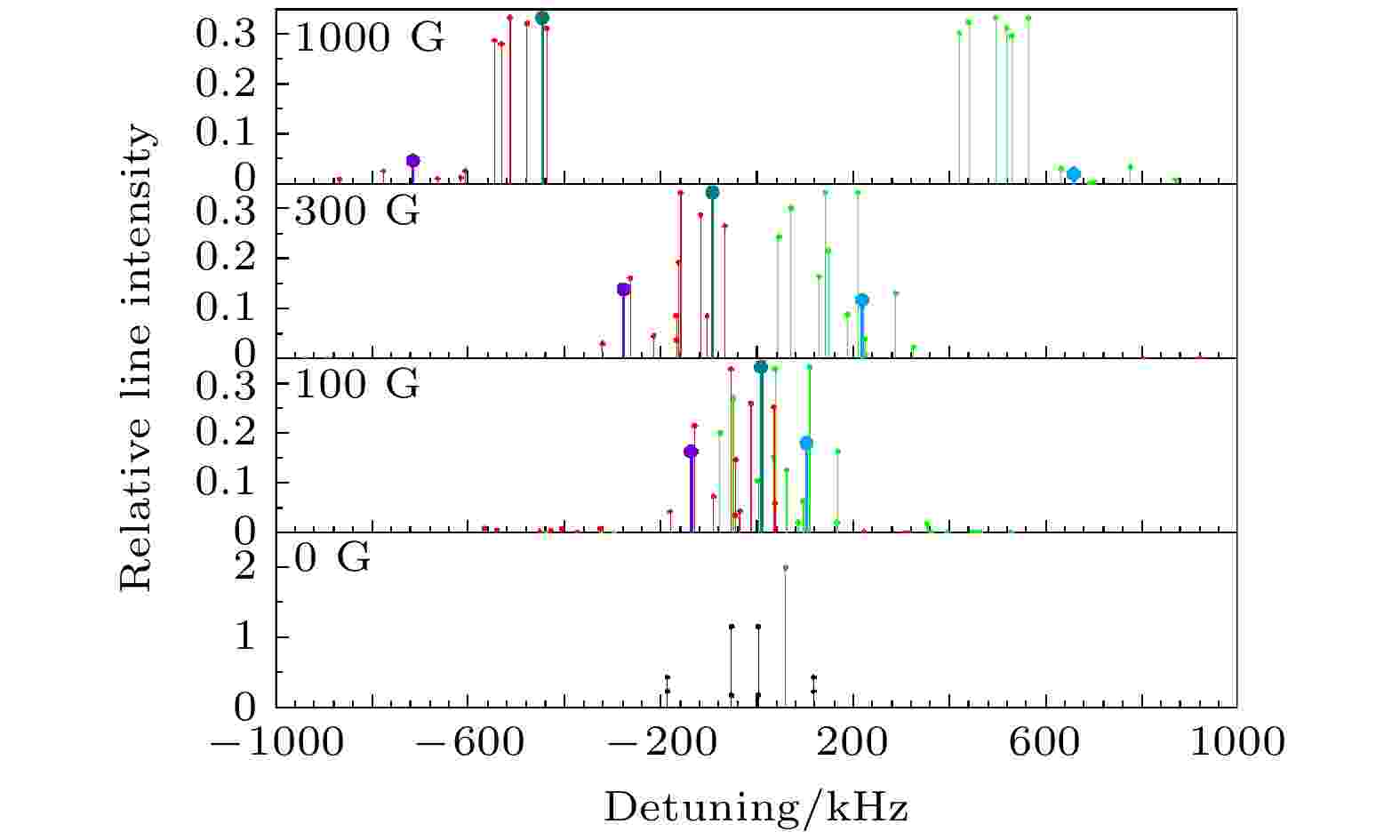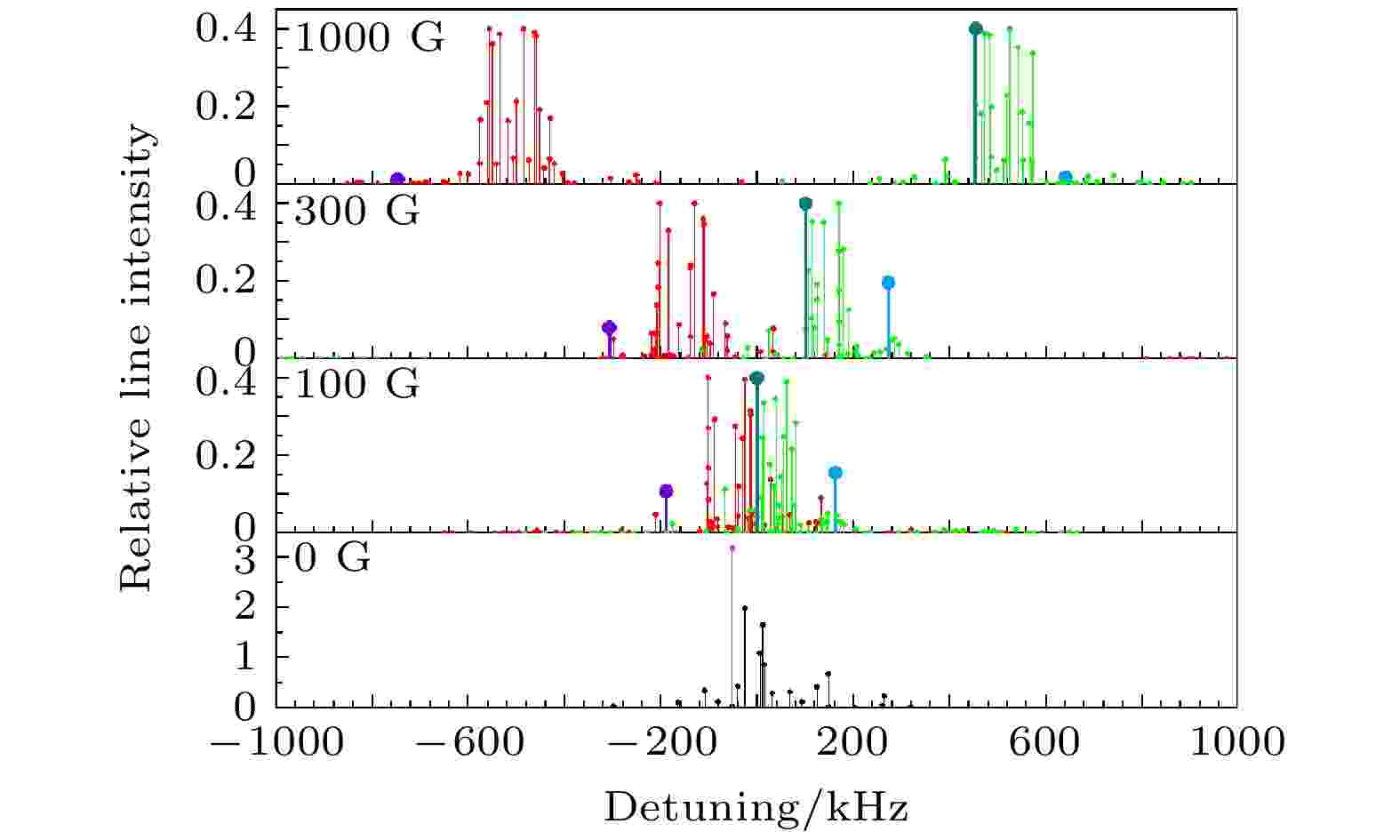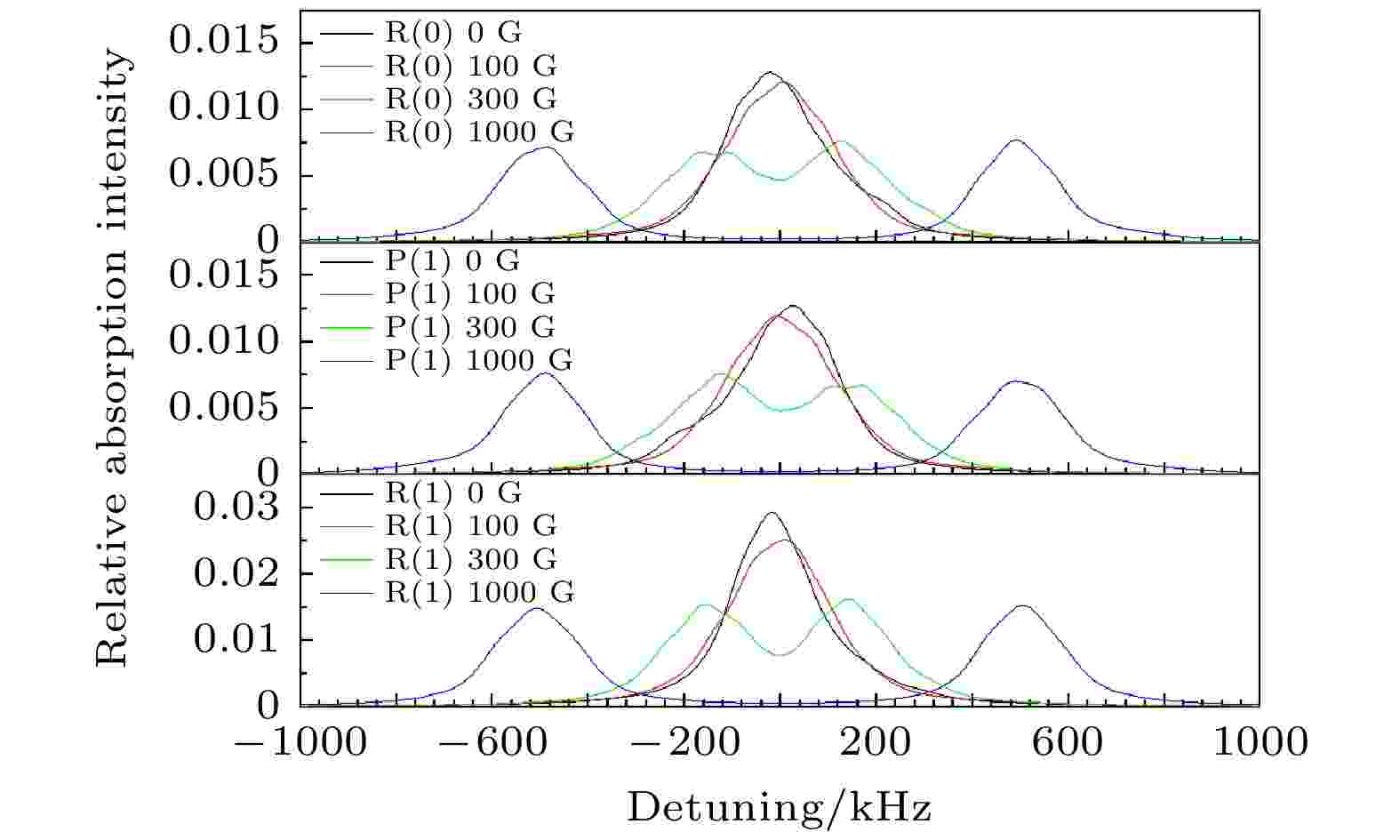全文HTML
--> --> -->60多年前, Quinn等[16]利用磁共振方法研究过HD分子基态的超精细结构, 近期, Dupre[17]和Komasa等[18]分别计算了HD分子红外跃迁的超精细结构, 在未考虑测量中泵浦探测效应的情况下, 得到了基本一致的跃迁结构, 但仍然难以预测实验条件下的光谱线型, 不能和实验结果进行直接对比. Pachalski等[19]认为, HD超精细结构的精密测量对于精确认识氘原子电四极矩, 理解自旋依赖的核子相互作用有着重要意义. 本文提出, 通过在不同磁场下观测HD红外谱线结构的变化以检验其线型的模型. 本文将计算不同磁场下HD分子ν = 2—0带中各塞曼子能级间电偶极跃迁的结构. 由于分子间碰撞和能级布居转移的动力学效应对能级结构十分敏感, 通过实验和理论的比对, 有望判定HD分子红外跃迁呈现特别的非对称线型的真正机制.
 图 1 在磁场中测定HD分子振转跃迁
图 1 在磁场中测定HD分子振转跃迁Figure1. Determination of the ro-vibrational transition of HD molecule in magnetic field.
以下将分析HD振转跃迁在外磁场下的结构. 为减小谱线的渡越加宽、增加下态布居, 比较理想的实验方式将是在低温下测量R(0)谱线. 低温下HD分子主要布居在J = 0的转动能级, 相对来说, 超精细结构较为简单, 也有利于分辨其光谱结构. 因此, 本文将主要以ν = 2—0带中R(0)跃迁为例进行讨论. 当然, 相关的计算方法很容易推广到其他跃迁.
可以用两种表象分别来计算HD分子振转跃迁的超精细结构. 一种是选用N, iD, F1, iH, F, mF这6个量子数构成的耦合表象, 另一种是用N, mN, iH, mH, iD, mD这6个量子数构成的非耦合表象. 其中N是转动角动量量子数, iD, iH分别是氘、氢原子核自旋角动量量子数, F1, F为耦合得到的量子数, mF, mN, mH, mD为对应的磁量子数.
2
2.1.耦合表象
耦合表象下, 选用N, iD, F1, iH, F, mF这6个量子数构成的基函数. 此时, 可以认为HD分子的转动角动量N与氘原子核自旋角动量iD耦合为F1, F1再与氢原子核自旋角动量iH耦合为总角动量F, F在Z轴方向的投影记为mF, 如图2所示. 即 图 2 耦合表象下HD分子的角动量耦合示意图
图 2 耦合表象下HD分子的角动量耦合示意图Figure2. Angular momentums of the HD molecule in the coupled representation.

1: │1 1 0 1/2 1/2

2: │1 1 1 1/2 1/2

3: │1 1 1 1/2 3/2

4: │1 1 2 1/2 3/2

5: │1 1 2 1/2 5/2

系统的相互作用哈密顿量分为下面四个部分. 第一部分为分子转动与氢原子核自旋的相互作用, 其中cH为氢原子核的自旋-转动常数:

各超精细跃迁谱线相对线强度主要由各跃迁电偶极矩的平方|μul|2决定, 计算下能级a, b两个态分别到上能级A, B, C, D, E五个态的跃迁电偶极矩的平方即可得到所有超精细跃迁谱线的相对线强度.
根据文献[17], 上下能级间的跃迁电偶极矩 ,










 图 3 计算得到的HD分子ν = 2—0带R(0)线的所有超精细跃迁谱线的频率偏移及其对应的相对线强度(有部分弱线在显示范围之外)
图 3 计算得到的HD分子ν = 2—0带R(0)线的所有超精细跃迁谱线的频率偏移及其对应的相对线强度(有部分弱线在显示范围之外)Figure3. Calculated frequency shifts of all hyperfine transition lines in the R(0) line in the ν = 2–0 band and their corresponding line intensities (some weak lines are outside the display range).
2
2.2.非耦合表象
也可以选择N, mN, iH, mH, iD, mD这6个量子数构成的非耦合基来进行计算. 此时, 可以认为HD分子的转动角动量N、氘原子核自旋角动量iD以及氢原子核自旋角动量iH分别与磁场耦合. 对于HD ν = 2—0带的R(0)线, 上能级ν = 2; N = 1; mN = 0, ± 1; mH = ± 1/2; mD = 0, ± 1, 共有3 × 2 × 3=18组基. 下能级ν = 0; N = 0; mN = 0; mH = ± 1/2; mD = 0, ± 1, 共有2 × 3 = 6组基. 在无外加磁场的情况下, 按照Ramsey和Lewis[22]的表示方法, 系统的有效哈密顿量为在有磁场情况下, 采用非耦合表象更为方便. 从N, mN, iH, mH, iD, mD这6个量子数构成的非耦合表象出发, 按照Ramsey和Lewis[22]的表示方法, 系统的有效哈密顿量为
其中, 前两项对应于核磁矩与外加磁场的相互作用, 第三项为分子转动磁矩与外加磁场的相互作用, 第四项和第五项对应于自旋转动磁相互作用, 第六项对应于两个核自旋磁矩之间的偶极-偶极相互作用, 第七项代表氘核电四极矩的相互作用. 式中H为磁场强度, 单位为G (

取磁场方向为Z方向, 由于光的方向与磁场方向相同, 这时只能探测Δm = + 1和Δm = –1的跃迁. 因此以下只考虑这两种跃迁, 而不考虑Δm = 0的跃迁. Hhfs中前三项角动量算符只有Z方向的分量, 因此其对应的哈密顿矩阵元只有对角项不为零, 根据(17)式可以很容易算出. 而后四项哈密顿矩阵元的计算与2.2节中的计算方法相同. 得到哈密顿矩阵后, 求本征值和本征向量, 即可得到上、下能级分别在对应磁场下的各超精细分裂能级的能量移动和本征波函数, 由每条跃迁谱线上下能级的能量移动即可得到该跃迁谱线的频率移动. 按照(13)式的叠加方法, 从非耦合表象基之间的跃迁矩按照叠加系数叠加即可得到对应超精细跃迁的跃迁矩, 进而得到每条超精细跃迁谱线的相对跃迁强度. 在100, 300 和1000 G的外加磁场下计算得到的结果分别如图3上面三部分所示. 结果的具体数值如表1所列. 图3中频率偏移的零点对应于不考虑超精细分裂结构时的跃迁频率. 相对跃迁强度的值取对应的跃迁电偶极矩的平方. 在加上外加磁场后, 跃迁分为Δm = + 1和Δm = –1两支, 分别用红、绿两种颜色标注. 为了显示某一条跃迁在考虑塞曼分裂后随磁场强度的变化, 选出了3条线分别用深紫、墨绿、蓝三种颜色的粗线标出, 这3条线都由无外加磁场中的紫色线分裂而出.
| 跃迁线 | 0 G | 100 G | 300 G | 1000 G | ||||||||
| 频率偏移/kHz | 相对强度 | 频率偏移/kHz | 相对强度 | 频率偏移/kHz | 相对强度 | 频率偏移/kHz | 相对强度 | |||||
| Δm = + 1 | a→A | –56.3 | 0.3333 | –106.9 | 0.3333 | –208.0 | 0.3333 | –561.9 | 0.3333 | |||
| b1→B1 | –56.3 | 0.0000 | –100.6 | 0.1800 | –216.4 | 0.1157 | –656.9 | 0.0197 | ||||
| b1→B2 | –1.4 | 0.2922 | –33.3 | 0.1533 | –146.5 | 0.2176 | –516.3 | 0.3136 | ||||
| b1→B3 | 53.3 | 0.0411 | 323.4 | 0.0000 | 940.3 | 0.0000 | 3108.3 | 0.0000 | ||||
| b2→B1 | –56.3 | 0.2000 | –461.0 | 0.0019 | –1297.6 | 0.0003 | –4261.1 | 0.0000 | ||||
| b2→B2 | –1.4 | 0.0164 | –393.7 | 0.0018 | –1227.7 | 0.0001 | –4120.5 | 0.0000 | ||||
| b2→B3 | 53.3 | 0.1169 | –37.0 | 0.3297 | –141.0 | 0.3329 | –495.9 | 0.3333 | ||||
| c1→C1 | –114.1 | 0.1439 | –165.4 | 0.1619 | –286.0 | 0.1273 | –776.7 | 0.0315 | ||||
| c1→C2 | –56.3 | 0.0000 | –93.4 | 0.0640 | –222.5 | 0.0372 | –699.2 | 0.0029 | ||||
| c1→C3 | –1.4 | 0.0974 | –2.2 | 0.1070 | –129.5 | 0.1688 | –528.6 | 0.2990 | ||||
| c1→C4 | 53.3 | 0.0137 | 298.6 | 0.0000 | 893.3 | 0.0000 | 2972.7 | 0.0000 | ||||
| c1→C5 | 179.3 | 0.0783 | 432.1 | 0.0004 | 1032.2 | 0.0000 | 3181.2 | 0.0000 | ||||
| c2→C1 | –114.1 | 0.0196 | –525.8 | 0.0018 | –1367.3 | 0.0004 | –4380.9 | 0.0000 | ||||
| c2→C2 | –56.3 | 0.1000 | –453.8 | 0.0025 | –1303.8 | 0.0002 | –4303.5 | 0.0000 | ||||
| c2→C3 | –1.4 | 0.0219 | –362.6 | 0.0015 | –1210.8 | 0.0003 | –4132.8 | 0.0000 | ||||
| c2→C4 | 53.3 | 0.1559 | –61.9 | 0.1248 | –188.0 | 0.0859 | –631.6 | 0.0292 | ||||
| c2→C5 | 179.3 | 0.0360 | 71.7 | 0.2028 | –49.1 | 0.2465 | –423.0 | 0.3040 | ||||
| d→D1 | –114.1 | 0.0587 | –445.7 | 0.0018 | –1309.3 | 0.0001 | –4366.4 | 0.0000 | ||||
| d→D2 | –56.3 | 0.0333 | –353.7 | 0.0170 | –1198.0 | 0.0018 | –4198.3 | 0.0002 | ||||
| d→D3 | –1.4 | 0.0164 | –163.3 | 0.0232 | –321.7 | 0.0236 | –867.0 | 0.0083 | ||||
| d→D4 | 53.3 | 0.1169 | –84.8 | 0.0197 | –223.8 | 0.0063 | –690.0 | 0.0002 | ||||
| d→D5 | 179.3 | 0.1079 | 45.6 | 0.2716 | –73.9 | 0.3015 | –442.1 | 0.3247 | ||||
| Δm =–1 | a→C1 | –114.1 | 0.0587 | –34.7 | 0.0616 | 106.1 | 0.0884 | 530.4 | 0.2835 | |||
| a→C2 | –56.3 | 0.0333 | 37.3 | 0.0446 | 169.6 | 0.0865 | 607.9 | 0.0249 | ||||
| a→C3 | –1.4 | 0.0164 | 128.5 | 0.2139 | 262.6 | 0.1567 | 778.5 | 0.0248 | ||||
| a→C4 | 53.3 | 0.1169 | 429.2 | 0.0046 | 1285.4 | 0.0006 | 4279.8 | 0.0001 | ||||
| a→C5 | 179.3 | 0.1079 | 562.8 | 0.0086 | 1424.3 | 0.0011 | 4488.3 | 0.0001 | ||||
| b1→D1 | –114.1 | 0.1439 | 45.5 | 0.1473 | 164.2 | 0.1950 | 545.0 | 0.2888 | ||||
| b1→D2 | –56.3 | 0.0000 | 137.5 | 0.1648 | 275.5 | 0.1368 | 713.1 | 0.0444 | ||||
| b1→D3 | –1.4 | 0.0974 | 327.9 | 0.0085 | 1151.7 | 0.0003 | 4044.4 | 0.0000 | ||||
| b1→D4 | 53.3 | 0.0137 | 406.4 | 0.0081 | 1249.6 | 0.0008 | 4221.4 | 0.0001 | ||||
| b1→D5 | 179.3 | 0.0783 | 536.8 | 0.0045 | 1399.5 | 0.0004 | 4469.3 | 0.0000 | ||||
| b2→D1 | –114.1 | 0.0196 | –314.9 | 0.0001 | –917.1 | 0.0000 | –3059.2 | 0.0000 | ||||
| b2→D2 | –56.3 | 0.1000 | –222.9 | 0.0021 | –805.8 | 0.0000 | –2891.1 | 0.0000 | ||||
| b2→D3 | –1.4 | 0.0219 | –32.5 | 0.2496 | 70.4 | 0.2653 | 440.2 | 0.3123 | ||||
| b2→D4 | 53.3 | 0.1559 | 46.0 | 0.0372 | 168.4 | 0.0383 | 617.2 | 0.0125 | ||||
| b2→D5 | 179.3 | 0.0360 | 176.4 | 0.0442 | 318.3 | 0.0297 | 865.2 | 0.0085 | ||||
| c1→E1 | –56.3 | 0.0000 | 55.2 | 0.3291 | 159.4 | 0.3329 | 514.4 | 0.3333 | ||||
| c1→E2 | –1.4 | 0.2922 | 375.0 | 0.0019 | 1201.0 | 0.0001 | 4084.7 | 0.0000 | ||||
| c1→E3 | 53.3 | 0.0411 | 452.7 | 0.0023 | 1297.2 | 0.0003 | 4269.7 | 0.0000 | ||||
| c2→E1 | –56.3 | 0.2000 | –305.3 | 0.0003 | –921.9 | 0.0000 | –3089.9 | 0.0000 | ||||
| c2→E2 | –1.4 | 0.0164 | 14.6 | 0.2593 | 119.7 | 0.2884 | 480.5 | 0.3223 | ||||
| c2→E3 | 53.3 | 0.1169 | 92.3 | 0.0737 | 215.9 | 0.0450 | 665.5 | 0.0110 | ||||
| d→F | –56.3 | 0.3333 | –5.8 | 0.3333 | 95.3 | 0.3333 | 449.3 | 0.3333 | ||||
表1计算得到的R(0)线所有超精细跃迁谱线的频率偏移及其对应的相对线强度
Table1.Calculated frequency shifts of all hyperfine transition lines in the R(0) line and their corresponding line intensities
从图3可以看出, 当外加磁场强度较大时, 超精细跃迁谱线明显分为两支, 分别为Δm = + 1和Δm = –1的跃迁. 随着外加磁场强度的增大, 各超精细跃迁谱线频率偏移的数值也在增大. 可以看出, 当外加磁场强度达到1000 G时, 两支超精细跃迁谱线已经完全分开, 此时分子转动角动量以及原子核自旋角动量之间的相互作用已经远小于外加磁场导致的磁能级的分裂, 此时使用非耦合表象更加直观.
同时, 我们也分别在无外加磁场以及100, 300, 1000 G外加磁场的条件下, 按照上述的计算方法计算了HD分子ν = 2—0带中P(1), R(1)线的超精细分裂结构及各超精细跃迁谱线的相对线强度. 得到的结果分别如图4和图5所示, 频率偏移的零点对应于不考虑超精细分裂结构时的跃迁频率, 相对跃迁强度的值取对应的跃迁电偶极矩的平方, 不同颜色的标注与图3中的意义相同.
 图 4 计算得到的HD分子ν = 2—0带P(1)线的所有超精细跃迁谱线的频率偏移及其对应的相对线强度(有部分弱线在显示范围之外)
图 4 计算得到的HD分子ν = 2—0带P(1)线的所有超精细跃迁谱线的频率偏移及其对应的相对线强度(有部分弱线在显示范围之外)Figure4. Calculated frequency shifts of all hyperfine transition lines of ν = 2–0 band P (1) lines of HD molecule and their corresponding relative line intensities (some weak lines are outside the display range).
 图 5 计算得到的HD分子ν = 2—0带R(1)线的所有超精细跃迁谱线的频率偏移及其对应的相对线强度(有部分弱线在显示范围之外)
图 5 计算得到的HD分子ν = 2—0带R(1)线的所有超精细跃迁谱线的频率偏移及其对应的相对线强度(有部分弱线在显示范围之外)Figure5. Calculated frequency shifts of all hyperfine transition lines of HD molecule ν = 2–0 band R (1) line and their corresponding relative line intensities (some weak lines are outside the display range).
将计算得到的超精细跃迁谱线以相对强度为权重做加权平均, 可以发现两支超精细跃迁谱线叠加后的光谱中心位置的频率偏移与磁场强度都基本成线性关系, 斜率分别为0.5056和–0.5056 kHz/G, 如图6所示.
 图 6 HD分子R(0) (ν = 2—0)跃迁在轴向磁场下, Δm = + 1和Δm = –1两支超精细跃迁谱线光谱中心的频率偏移与磁场强度的关系
图 6 HD分子R(0) (ν = 2—0)跃迁在轴向磁场下, Δm = + 1和Δm = –1两支超精细跃迁谱线光谱中心的频率偏移与磁场强度的关系Figure6. Relationship between the magnetic field intensity and the frequency shift of the spectral center of the Δm = + 1 and Δm = – 1 hyperfine transitions of the R(0) (ν = 2–0) line of HD.



本文在理论上模拟了在10 K的低温条件下, 分别在无磁场、100 G外加磁场、300 G外加磁场、1000 G外加磁场下HD分子ν = 2—0带R(0), P(1), R(1)线的光谱. 模拟中只考虑了Δm = + 1和Δm = –1的跃迁. 由于recoil效应产生的分裂, 每条超精细跃迁谱线都分为间距为2δ的两个峰. 每个峰都用FWHM为99 kHz的洛伦兹线型来模拟, 模拟得到的结果如图7所示.
 图 7 在10 K的低温条件下, 分别在不同外加磁场下模拟的HD分子(2—0)带R(0)线、P(1)线、R(1)线的光谱
图 7 在10 K的低温条件下, 分别在不同外加磁场下模拟的HD分子(2—0)带R(0)线、P(1)线、R(1)线的光谱Figure7. Simulated spectra of R (0), P (1) and R (1) lines in the (2–0) band of HD under different magnetic fields at the temperature of 10 K.
